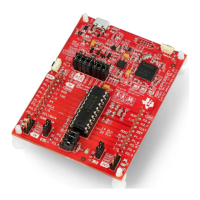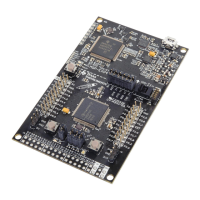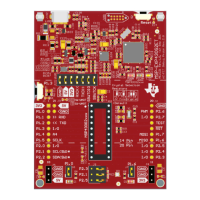www.ti.com
Hardware
2.3.5 14-Pin JTAG Connector
This EVM contains a footprint for TI's standard 14-pin MSP430 JTAG header. This connector can be used
as needed. For debug purposes, this connector offers 4-wire JTAG compared to the 2-wire Spy-Bi-Wire
from the eZ-FET. In certain use cases this can be advantageous. The MSP-FET or another MSP430
external debug tool such as MSP-FET430UIF or third-party tool can be used. This JTAG connector can be
used to power the system directly or can be used with external power. The MSP-FET tool supports
EnergyTrace™ technology and can perform the same measurements as the eZ-FET onboard emulator.
See Section 2.4 for more details on the JTAG system power requirements.
2.3.6 Using the eZ-FET Emulator With a Different Target
The eZ-FET emulator on the FR5969 LaunchPad can interface to most MSP430 derivative devices, not
just the on-board FR5969 target device.
To do this, disconnect every jumper in the isolation jumper block. This is necessary because the emulator
cannot connect to more than one target at a time over the Spy-Bi-Wire (SBW) connection.
Next, make sure the target board has proper connections for Spy-Bi-Wire. Note that to be compatible with
SBW, the capacitor on RST/SBWTDIO cannot be greater than 2.2 nF. The documentation for designing
MSP430 JTAG interface circuitry is the MSP430 Hardware Tools User's Guide (SLAU278).
Finally, wire together these signals from the emulator's side of the isolation jumper block to the target
hardware:
• 3.3 V (V+)
• GND
• SBWTDIO
• SBWTCK
• TXD (if the UART backchannel is to be used)
• RXD (if the UART backchannel is to be used)
• CTS (if hardware flow control is to be used)
• RTS (if hardware flow control is to be used)
This wiring can be done either with jumper wires or by designing the board with a connector that plugs into
the isolation jumper block.
15
SLAU535B–February 2014–Revised July 2015 MSP430FR5969 LaunchPad™ Development Kit (MSP
‑
EXP430FR5969)
Submit Documentation Feedback
Copyright © 2014–2015, Texas Instruments Incorporated

